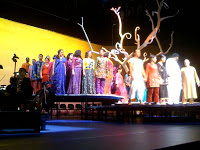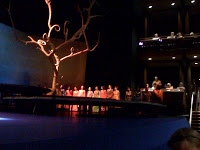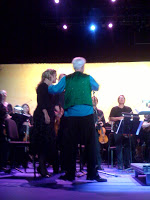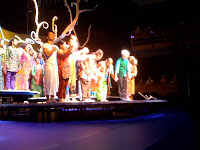| Numinous The Music of Joseph C. Phillips Jr. |
The Numinosum Blog
|
Last night I went to a performance of the latest opera of John Adams, A Flowering Tree. Based on a 2000 year old South Indian folk tale, this performance was a part of Lincoln Center's Mostly Mozart Festival and featured singers Sanford Sylvan, Jessica Rivera, and Russell Thomas, the Orchestra of St. Luke's, a trio of Javanese dancers, and the ScholaCantorum de Venezuela directed by Maria Guinand. And you may ask, what does composer John Adams, Javanese dancers, a ancient Indian folk tale, and a choir from Venezuela and often singing in Spanish, have to do with Mozart? Well, after earlier this year reading John Adams' autobiography Hallelujah Junction (and also retold by director Peter Sellars in a post-performance discussion) the story was that Peter Sellars was asked in 2006 to direct the New Crowned Hope Festival in Vienna to celebrate the 250th anniversary of Mozart's birth. And when Peter asked John if he could write something for the Festival, John replied, "I want to do Magic Flute!". And with that, the seed that was later to become A Flowering Tree was planted.
John Adams wrote in the program of last night's performance: Mozart was my first composer. His clarinet concerto was the first serious work I mastered as a performer. The three late symphonies, his string quintets, and almost all of his piano concertos were, and continue to be, canonical items for my musical imagination. When I first began to struggle with tonal harmony my teacher gave me a full score of Don Giovanni and told me to memorize not only the arias and ensembles but even the recitatives. A biography of Mozart provided the launch pad for my life as a composer. Decades later Die Zauberflöte (The Magic Flute), his Enlightenment statement about youth, initiation, and the dawning of moral awareness, provided the model for my own opera A Flowering Tree. In the opening, a storyteller (Sanford Sylvan) introduces a Prince (Russell Thomas) and Kumudha (Jessica Rivera), a poor young women who "magically morphs into a tree, undergoing myriad transformations, to help her poor family." Also on stage for most of the opera were the three Javanese dancers (Rusini Sidi, Eko Supriyanto, and Astri Kusuma Wardani) who were non-singing avatars of Kumudha, the mother/sister, and later the Prince. This parallel action, while far from being a jejune distraction was actually quite effective and moving: the dancers, as the singers were singing, could actually show the interior emotions of the characters in ways words couldn't. The entire first act was devoted to Kumudha and how through the act of transformation, the sale of flowers gathered from her tree form helped her family. The Prince, who was an aimless sort, one day by chance spiedKumudha transforming and goes to his father and says of Kumudha, "She troubles me, she troubles me". And the father brings her to the palace to become the Prince's wife. However the Prince really wants her to transform into the tree ("your gift belongs to me") and after she agrees to show him, she returns back to human form and they make love for the first time among the fragrant petals of Kumudha. Of course this being opera, there has to be conflict! The second Act while starting off with the happy couple in the palace slowly mutates to a scene with the jealous and envious sister of the Prince, 'tricking' Kumudha while the Prince is away, into performing her gift. And while in mid-change during the transformation ritual, the sister and a group of friends break branches and tear off flowers from Kumudha's treeself, leaving her unable to return to a wholly human form. Now somewhere between human and tree, this grotesque stump crawls away ("like a worm"), ashamed and dishonored. The Prince upon his return searches for his wife to no avail. So he forsakes all his princely riches and wanders the country as an ascetic. At the end they find each other and when he realizes that stump is his wife, he performs the magic ritual to return her to beauty and human form once again. How to describe such a magical performance and work? First, rarely do I sit so close (I was in the first row, about 10 feet directly behind John Adams as he was conducting-the orchestra was on-stage with the singers, choir, and dancers). It brought another level of excitement to see and feel the reactions of all the performers so intimately. There were many gorgeous and wonderful moments in the opera: the incredibly fluid dancing by the Javanese dancers (imagine a blend of graceful Tai Chi and Bollywood-esquemovement); the choir's first entrance (accompanied by lovely orchestration and harmonic motion) which was so quietly angelic and ethereal one would have thought the heavens were opening up and welcoming you; the wonderful "Flowers, Flowers, Lovely Flowers!" also sung by the choir during Kumudha's first transformation in the first Act (brought to mind the echos of ecstasy found in "Wild Nights" from Adams's Harmonium); the end of the first Act when the Kumudha performs the Flowering Tree transformation for her new husband and they embrace as if meeting for the last time; the singing of the Prince throughout, whose forceful and ringing voice was often stirring and moving; a virtuosic violin interlude in Act 1; the gorgeously intertwined duet in the second Act between the lovers; the "Monkey Chant" of the second Act; the glowing harmonic and rhythmic build-up of tension and awakening, mirrored in the lighting which changed from darkness to a beautific golden orange, all climaxing in a glorious unison pitch as the Prince completes transformation of the stump back into a human during the final moments of the opera. As an aside one of the first things I noticed just as the opera started was the choir. Seated around the perimeter of the opera set, they were all dressed in colorful saris and kurtas (even John Adams had a colorful green vest). And when they came onto the set, one was struck by how attractive and beautifully diverse they were. All sizes, hues and colors and all very dynamic and engaging when they sang. Particularly there was one female singer in a blue sari (see below photo), whose attentiveness to watching John Adams conducting was as a lover to her partner, and while all of the choir to varying degrees were emotive, this one young women was quite mesmerizing (actually talking with my friend afterwards, I found he was thinking the same thing throughout the opera!). Truly they were the "Greek choir" that not only commented on the action, they were a part of it (for example, they were the friends beckoning Kumudha to transform). And whenever they sang or were on stage, these were some of my favorites parts of the opera, both theatrically (for example, the opening hand gestures of an upturned cupped hand 'popping' open to the sky like a flower bud was evocative) and musically (some of the most inventive and beguiling music was during the choruses). During the opera it was interesting to hear how echos of past John Adams (from Harmonium to El Nino) as well as influences from Steve Reich to more ethnic musics, all were woven together in a subtle language that was decidedly John Adams. And the post-performance discussion with Peter Sellars and Maria Guinard was informative; hearing Peter Sellars speak about art and creativity and democracy was very inspiring. I really wished I could have seen A Flowering Tree again immediately after because there was so much richness and life and beauty there, it was difficult to take all in on one viewing. I must say it all was very inspiring to me to see such creativity and imagination which wasn't afraid to touch on both the sorrows and joys of life. It was a 'thinking space' or "a repose in a world often filled with horrors and terrors" that offered its own poignant, challenging, and unflinching mediation into the redemptive and restorative power of love. POSTED BY NUMINOUS AT 10:00 AM
0 Comments
Your comment will be posted after it is approved.
Leave a Reply. |
The NuminosumTo all things that create a sense of wonder and beauty that inspires and enlightens. Categories
All
|
Thanks and credit to all the original photos on this website to: David Andrako, Concrete Temple Theatre, Marcy Begian, Mark Elzey, Ed Lefkowicz, Donald Martinez, Kimberly McCollum, Geoff Ogle, Joseph C. Phillips Jr., Daniel Wolf-courtesy of Roulette, Andrew Robertson, Viscena Photography, Jennifer Kang, Carolyn Wolf, Mark Elzey, Karen Wise, Numinosito. The Numinous Changing Same album design artwork by DM Stith. The Numinous The Grey Land album design and artwork by Brock Lefferts. Contact for photo credit and information on specific images.




 RSS Feed
RSS Feed